Chignik, Alaska Peninsula, Alaska
 Chignik means ‘strong wind’. While the settlement of Chignik is in a bay (Anchorage Bay) with good shelter from most directions, it is subject to williwaws. It was sad to see the remains of a fibreglass sailboat on the beach. We were told it anchored in the bay one night, a wind came up and drove it ashore.Chignik is basically a cannery settlement–during the off-season–when we arrived, about 70 people live there. We tied up to the cannery dock to take on fuel, refill the propane bottles and use the telephone.
Chignik means ‘strong wind’. While the settlement of Chignik is in a bay (Anchorage Bay) with good shelter from most directions, it is subject to williwaws. It was sad to see the remains of a fibreglass sailboat on the beach. We were told it anchored in the bay one night, a wind came up and drove it ashore.Chignik is basically a cannery settlement–during the off-season–when we arrived, about 70 people live there. We tied up to the cannery dock to take on fuel, refill the propane bottles and use the telephone.
Monthly Archives: September 2011
Castle Cape
Castle Cape, Alaska Peninsula, Alaska
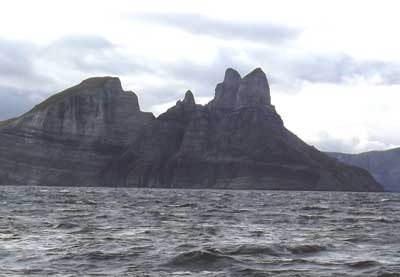 Alternating layers of light and dark colored rock make Castle Cape interesting to look at. We sailed past Castle Cape, then spent much of the night sailing to windward in Force 5-6 winds in Chignik Bay, before heaving to for several hours to wait for daylight to enter Chignik.
Alternating layers of light and dark colored rock make Castle Cape interesting to look at. We sailed past Castle Cape, then spent much of the night sailing to windward in Force 5-6 winds in Chignik Bay, before heaving to for several hours to wait for daylight to enter Chignik.
Haystacks
Shumagin Islands, Alaska
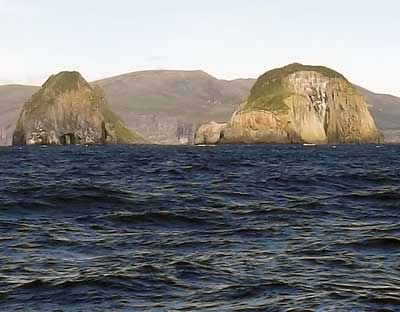 To get from the Bering Sea to the Pacific Ocean, one needs to go thru one of the passes between islands in the Aleutian Islands. There are tidal currents, often strong, in the passes, which result in tide rips, overfalls, and generally choppy water when strong wind opposes the strong tides. I wanted to go thru the nearest pass to Dutch Harbor, Unalga pass, because it is short and scenic. Being short, you are thru it quickly, even if the ride is exciting, one doesn’t need to be concerned about taking so long to get thru that the tide changes and then opposes the wind (causing rough seas). We were not ready to leave Dutch Harbor until late in the afternoon (too busy getting stuff done), and to go thru Unalga pass would have meant going thru at night–where it could be difficult to see the tide rips as there was not much of a moon, or waiting until the next day. The other option was to take the biggest and farthest away pass, Unimak, where the currents are not very strong. Unimak Pass is much longer, so the current would not always be in our favor, but we had light winds forecast, so no concerns about rough seas that night. So we sailed and motored and motorsailed thru the night to Unimak Pass and into the Pacific Ocean. Shortly after getting out of the pass and beyond the pseudo-traffic-lane setup they have there, the wind picked up, and we ended up heaving to for the night in the lee of some reefs, which broke the seas up. The next day we continued sailing. We later hove to near the Shumagin Islands, so we could go thru them in daylight. There was a chance of strong winds funneling between the islands, and we weren’t too sure of the currents, so it seemed best to go thru during daylight. As a result, we got to see The Haystacks. The rocks in the picture are part of The Haystacks, and are located south of the Alaska Peninsula in the Shumagin Islands. I’ll talk more about the routing decision later.
To get from the Bering Sea to the Pacific Ocean, one needs to go thru one of the passes between islands in the Aleutian Islands. There are tidal currents, often strong, in the passes, which result in tide rips, overfalls, and generally choppy water when strong wind opposes the strong tides. I wanted to go thru the nearest pass to Dutch Harbor, Unalga pass, because it is short and scenic. Being short, you are thru it quickly, even if the ride is exciting, one doesn’t need to be concerned about taking so long to get thru that the tide changes and then opposes the wind (causing rough seas). We were not ready to leave Dutch Harbor until late in the afternoon (too busy getting stuff done), and to go thru Unalga pass would have meant going thru at night–where it could be difficult to see the tide rips as there was not much of a moon, or waiting until the next day. The other option was to take the biggest and farthest away pass, Unimak, where the currents are not very strong. Unimak Pass is much longer, so the current would not always be in our favor, but we had light winds forecast, so no concerns about rough seas that night. So we sailed and motored and motorsailed thru the night to Unimak Pass and into the Pacific Ocean. Shortly after getting out of the pass and beyond the pseudo-traffic-lane setup they have there, the wind picked up, and we ended up heaving to for the night in the lee of some reefs, which broke the seas up. The next day we continued sailing. We later hove to near the Shumagin Islands, so we could go thru them in daylight. There was a chance of strong winds funneling between the islands, and we weren’t too sure of the currents, so it seemed best to go thru during daylight. As a result, we got to see The Haystacks. The rocks in the picture are part of The Haystacks, and are located south of the Alaska Peninsula in the Shumagin Islands. I’ll talk more about the routing decision later.
Dutch Harbor
Dutch Harbor, Alaska
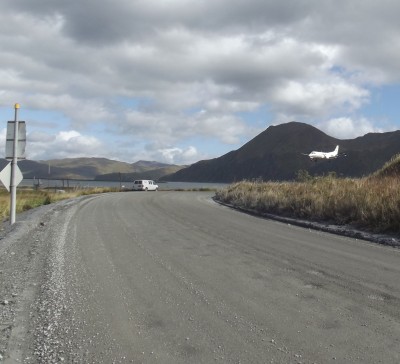 Plane coming in to land at Dutch Harbor airport. The road runs very close to the runway, so traffic must stop when planes are taking off or landing.
Plane coming in to land at Dutch Harbor airport. The road runs very close to the runway, so traffic must stop when planes are taking off or landing.
Spotlight on the Spit
Dutch Harbor, Alaska
 There are a few places to dock in Dutch Harbor. The rainbow and light making its way thru a break in the clouds are illuminating the Spit and the boats docked there. The spit is well protected, and easy to enter, but a long way from the rest of town. The harbormaster had us dock there because there was no room elsewhere. The big fishing season is about to start, so harbors are now full of boats waiting for the season to open.Frequent strong, sudden winds (williwaws) make their way down the slopes of the cliffs in Dutch Harbor. The winds don’t last long–up to fifteen minutes or so, but are strong, and it is nice to be tied to a strong dock when they arrive.
There are a few places to dock in Dutch Harbor. The rainbow and light making its way thru a break in the clouds are illuminating the Spit and the boats docked there. The spit is well protected, and easy to enter, but a long way from the rest of town. The harbormaster had us dock there because there was no room elsewhere. The big fishing season is about to start, so harbors are now full of boats waiting for the season to open.Frequent strong, sudden winds (williwaws) make their way down the slopes of the cliffs in Dutch Harbor. The winds don’t last long–up to fifteen minutes or so, but are strong, and it is nice to be tied to a strong dock when they arrive.
Dutch Harbor
Dutch Harbor, Alaska
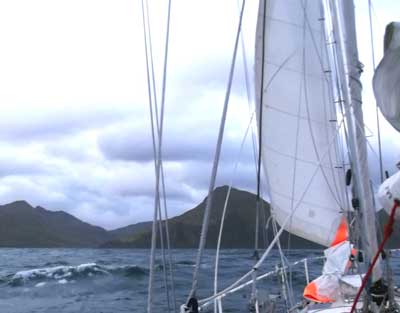 Dutch Harbor is all a rugged mountainous area. Lots of williwaws (wind coming down off the cliffs, suddenly resulting in high winds that last for several minutes) keep things interesting. As we arrived in Dutch Harbor on strong winds, we needed only one small jib to take us into the harbor. The harbormaster called us on the VHF radio as we entered, and told us where to dock.
Dutch Harbor is all a rugged mountainous area. Lots of williwaws (wind coming down off the cliffs, suddenly resulting in high winds that last for several minutes) keep things interesting. As we arrived in Dutch Harbor on strong winds, we needed only one small jib to take us into the harbor. The harbormaster called us on the VHF radio as we entered, and told us where to dock.
Scroll Down to See Latest Entries
Dutch Harbor, Alaska
Please scroll down to see the latest entries if you haven’t seen anything posted for a while. The latest entries are being posted in order of where we were, so they are farther down the page. The status of the satellite phone battery (and therefore the ability to use email aboard and make frequent posts) is not yet clear. Apologies for the confusion, at some point I’ll stop sailing and fixing long enough to catch up the blog :).Off
Bering Sea Rainbow
Bering Sea, Alaska
 We had great winds when sailing south from St Paul towards Dutch Harbor, as we left anchor just as the gale started to ease. We didn’t need many sails, and made good speed. The rainbow ahead was kind enough to show us the way.
We had great winds when sailing south from St Paul towards Dutch Harbor, as we left anchor just as the gale started to ease. We didn’t need many sails, and made good speed. The rainbow ahead was kind enough to show us the way.
St Paul
St Paul, Pribilof Islands, Bering Sea
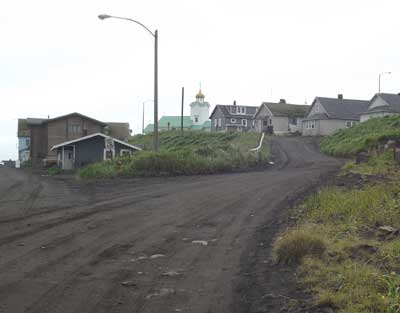 After sitting out the gales in Port Clarence, we had good northerly winds taking us south. We could have made it all the way to Dutch Harbor, but the forecast showed the northerly winds would be a gale by the time we reached Dutch Harbor, and while it looked like a safe entrance in a northerly gale, I hate entering unfamiliar places in gales–there is little room for correcting problems. So we went into the harbor of St Paul, one of the Pribilof Islands, about 230 miles north of the Aleutian islands. The cannery manager was nice to us and let us use their dock for a while. When some fishing boats came in later that night needing to unload, we moved out of the harbor and anchored nearby, in a location protected from the approaching NE gale.St Paul has a church, school, small hospital, weather station, general store and a library with internet access, which was nice. We spent three days sitting out gales in St Paul. After the wind moved from NE towards NW, we moved around to a different spot for better protection from NW. As the gale started to ease, we left, taking advantage of the gale’s strong northerly winds to get us to Dutch Harbor, planning to arrive when the winds were down to Force 7.
After sitting out the gales in Port Clarence, we had good northerly winds taking us south. We could have made it all the way to Dutch Harbor, but the forecast showed the northerly winds would be a gale by the time we reached Dutch Harbor, and while it looked like a safe entrance in a northerly gale, I hate entering unfamiliar places in gales–there is little room for correcting problems. So we went into the harbor of St Paul, one of the Pribilof Islands, about 230 miles north of the Aleutian islands. The cannery manager was nice to us and let us use their dock for a while. When some fishing boats came in later that night needing to unload, we moved out of the harbor and anchored nearby, in a location protected from the approaching NE gale.St Paul has a church, school, small hospital, weather station, general store and a library with internet access, which was nice. We spent three days sitting out gales in St Paul. After the wind moved from NE towards NW, we moved around to a different spot for better protection from NW. As the gale started to ease, we left, taking advantage of the gale’s strong northerly winds to get us to Dutch Harbor, planning to arrive when the winds were down to Force 7.
Update
Port Clarence harbor, AK
After a week of continuous charging, and warmer temperatures in the cabin due to motoring for a few hours (re-anchoring) and a warm front passing, the Iridium phone is working again. As you know from following the comments on earlier entries, the Iridium phone battery died shortly after we left Ulukhaktok (Holman). That was the spare battery, the original also did not work. These batteries are what those that don’t rely on them call “smart batteries”, as they have monitoring and charging circuits built in and are specialty items not widely available. Attempts to supplement the failed spare battery with external batteries wired into it were not successful. While it is great to have email again, I’m not sure how long the phone will continue to work, so please don’t be surprised if the blog stops suddenly again. Thanks for all the comments! Glad to see the messages sent by Inuvik Coast Guard Radio and Barrow Comm Center were received and posted. We had strong northerly winds taking us down the Chukchi sea and through the Bering Strait. We left the Bering Strait on Sept 8 at 2000 UTC. With a southerly gale in the forecast, we went into Port Clarence (a well-protected harbor, about 10 miles in diameter, site of an old LORAN station, nearby towns of Teller and Brevig Mission) and anchored. We’ve had one southerly gale after another since then. The main anchor (Raya) was holding well enough on the third try where we first anchored (with better protection from SW), it held well at first where we next anchored (with better protection from the expected SE winds that were coming), but when the wind picked up in the middle of the night, we were soon dragging the anchor along the bottom at two knots. We reanchored several times, closer to the windward beach in 4m of water, never getting a really good hold, and added the ondeck Fortress anchor as well. As there are three of us aboard, doing anchor watches is not hard, we are just all pretty much staying dressed and ready to reanchor at all times. I have a bunch of blog posts that I’ve not been able to put up. If the phone continues to work, or when we reach port (we are just anchored in the harbor, we are not near Teller or Brevig Mission at present), I’ll post them. These older posts will appear below this one, so please scroll down to see them.